An agroforestry practice with Indigenous roots, syntropic agriculture is gaining attention for its potential to improve soil health and productivity.
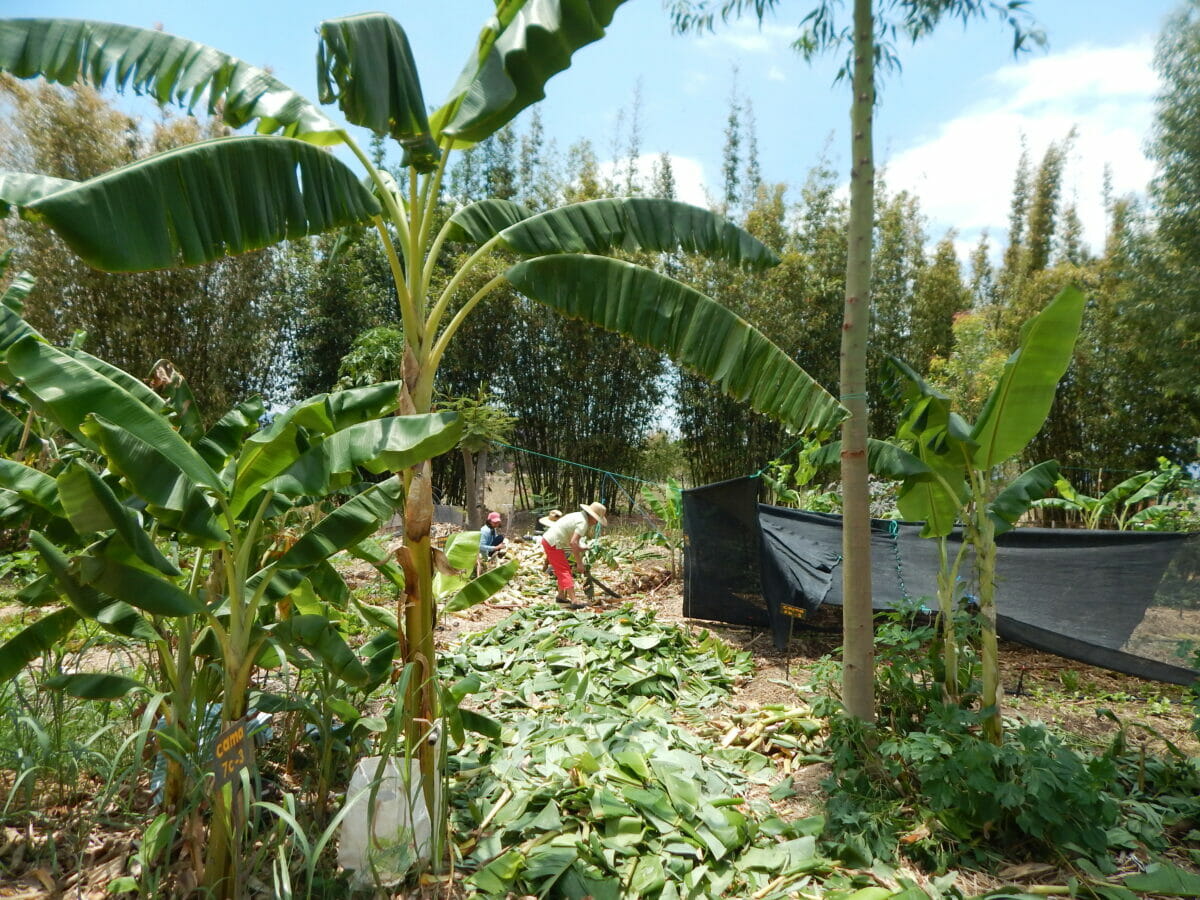
It’s almost 8 a.m. on a Monday morning in San Jerónimo Tlacochahuaya, and in spite of the early hour, the hot Mexican sun is already starting to beat down. In this Zapotecan town, located 15 miles east of Oaxaca City, 11 men and women don sombreros to protect themselves from the quickly strengthening rays and seek the shade provided by a row of banana and eucalyptus trees. The group clutches machetes as Letícia Sanchez explains the plan for the tequio, or collective work day.
“What we’re going to be doing today is pruning,” Sanchez tells the group. “We’ll start with the banana trees, and once we’ve thinned out that line, we’ll move on to the taller eucalyptus.” She explains that this is one of the most important tasks in agroforestry, because the hormones that the pruned branches release into the soil below will nourish plant beds and help the plants grow stronger and faster.
This location in Tlacochahuaya is called Tierra del Sol, a regenerative farming initiative and eco village founded in 1998 by Pablo Ruiz Lavalle, the site’s director. Formerly a commercial airline pilot, in that year Lavalle purchased one hectare—about two and a half acres—of land. Surrounded by plots characterized by intensive monocropping of crops such as corn, beans and alfalfa, the small area he purchased had been left unworked for some time and was in a sorry state. “The soil here was extremely compacted, there was very little organic material in it and it was stripped of any cover crops,” Lavalle says as we sit in an open-air gazebo on the property, accompanied by late-morning birdsong and the steady drone of forager honeybees flocking to Tierra del Sol’s scores of lavender plants.
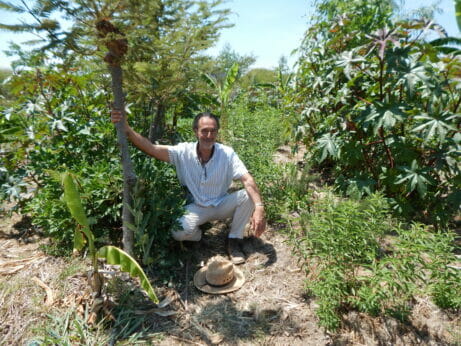
Pablo Ruiz Lavalle. (Photo: Lauren Rothman/Modern Farmer)
Glancing at the site’s neighboring parcels, where small-scale farmers work plots of the aforementioned crops using heavy applications of industrial pesticides and herbicides provided for free by the Mexican government, Lavalle’s description of the area’s not-too-distant past wasn’t hard to imagine. But looking over at Tierra del Sol’s garden plot, tall trees in various intensities of green swaying slowly above crops such as lettuce, broccoli, and a wide variety of herbs, it was more difficult to picture this land’s less-than-productive beginnings.
A key difference between Tierra del Sol and the dry, cracked farmland surrounding it? The practice of syntropic agriculture.
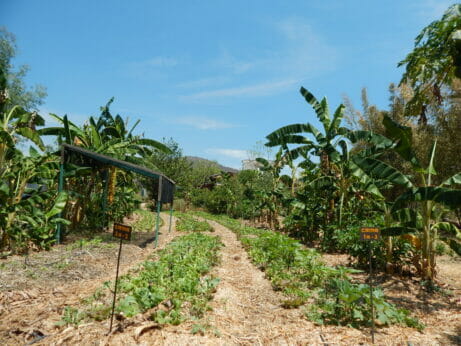
A view of Tierra del Sol’s plot of land. (Photo: Lauren Rothman/Modern Farmer)
The 4,500-square-meter plot where Sanchez would welcome volunteers to the tequio has been cultivated using principles of syntropic agriculture since 2019. This method of agroforestry, developed by the Swiss farmer and plant geneticist Ernst Götsch starting in the late 1970s, aims to work with nature, not against it, by reproducing certain principles of a naturally occurring forest in order to both cultivate food and rehabilitate the soil.
In syntropic agriculture spaces, plants are grown in different strata, beginning with low-to-the-ground vegetables, legumes, fruits, and herbs and culminating in a tree canopy that is populated by different species depending on the growing climate. Throughout the year, those trees are periodically pruned, with the consistent bring-down of organic material to the gardens below working to restore soil fertility, increase the diversity of microbes and fungi and ensure the health of the crops growing on the garden floor. Regular pruning of trees also manages the sun and shade conditions, further contributing to a balanced ecosystem. In the presence of a well-managed syntropic agriculture system, soil grows healthier, regenerating in one-third the time it would if left unassisted.
Born in 1948, Götsch relocated to Brazil in the early 1980s, eventually establishing himself and his family on 480 hectares of clear-cut Bahian forest that had been completely razed by the previous owner to produce lumber. There, with the initial intention of seeding a cacao plantation, Götsch set to work rehabilitating the land with his nascent principles of syntropic agriculture. In 1995, he published an early report on his farming methods, “Break-Through in Agriculture,” earning him local attention and acclaim. Today, Götsch’s verdant, ecologically diverse oasis in Brazil—a country known for its rampant deforestation practices—continues to attract the interest of advocates of regenerative agriculture.
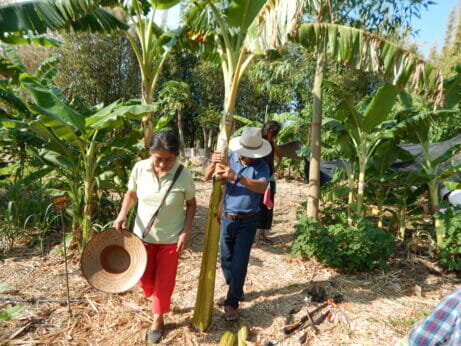
Volunteers pitch in during a work day at Tierra del Sol. (Photo: Lauren Rothman/Modern Farmer)
As the name “syntropic” implies, Götsch’s farming principles aim to produce more life, not less. As opposed to the entropic, chemical-heavy methods of monocropping that today dominate the global industrial farming landscape, syntropic systems increase matter and energy over time, building biodiversity and enriching soil fertility. And while the term syntropic agriculture is a fairly recent one, the practices it utilizes are anything but modern.
“It’s very important to recognize that when we talk about agroforestry, when we talk about syntropic agriculture, we’re talking about Indigenous agriculture,” says Namastê Messerschmidt, a longtime student and collaborator of Ernst Götsch who currently resides in Curitiba, in southern Brazil. In 2019, Sanchez, the consultant at Tierra del Sol, took a weeklong agroforestry course with Messerschmidt, and she came away so impressed with the techniques he imparted that she immediately convinced Lavalle, the center’s director, to pivot from the permaculture approach of hugelkultur—raised beds made of rotting logs and other plant debris—to syntropic agriculture. Tierra del Sol’s syntropic garden plot was seeded that same year.
According to Messerschmidt, cultures all over the world have always worked with the forest, planting their crops below the tree canopy and utilizing its abundant natural resources to boost their food production. As an example, he cites a phenomenon known in Brazil as “Indian black earth” or “Indigenous black earth”: a dark, humid soil found throughout the Amazon that’s highly fertile and rich in minerals such as calcium, magnesium and zinc. Once thought to be a natural phenomenon, this black earth is today recognized as the product of some eight thousand years of sustainable, Indigenous Brazilian agriculture, in which native Amazonian tribes domesticated crops such as yucca under a forest canopy of native trees such as cacao and mahogany.
“For me, agroforestry is doing things as nature does them,” says Messerschmidt. “There’s an intelligence in the forest that we’re simply allowing to unfold.”
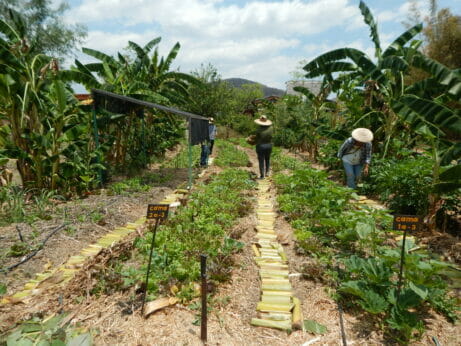
Lining paths with pruned material during a work day at Tierra del Sol. (Photo: Lauren Rothman/Modern Farmer)
At workshops, courses, and training all over the world as well as online, instructors including Messerschmidt, Götsch and others are spreading the gospel of syntropy—and people are listening.
“The demand is growing, and the need for it is even higher,” says Thiago Barbosa, the Australia-based founder of Syntropic Solutions, a designer and developer of agroforestry projects that helps individuals, companies and corporations transition from conventional to syntropic agriculture. Barbosa travels all over the world to teach workshops on agroforestry. He notes that the global interest in the practices is at an all-time high.
“At these workshops, I see more and more people from all walks of life,” he says. “Single moms that just want to have self-sufficiency, farmers who don’t want to spray with chemicals anymore, big corporations that are looking to meet their carbon targets.” In that last category is the cosmetics giant L’Oréal, at whose offices in Rio de Janeiro, Brazil, Syntropic Solutions planted an edible orchard of native fruit trees.
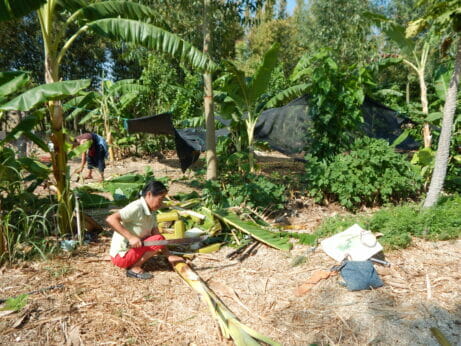
Using machetes during a work day at Tierra del Sol. (Photo: Lauren Rothman/Modern Farmer)
At Tierra del Sol, there’s evidence—observed both scientifically and anecdotally—that the center’s transition to syntropic agriculture has been a success. Sanchez tells me that, in 2021 and 2022, the garden’s team performed analyses of the soil using chromatography, which demonstrates soil health through markers such as mineral content and the presence of microorganisms. The second samples taken at Tierra del Sol showed increased oxygenation and a higher content of organic material than the year prior, says Sanchez. But the changes at Tierra del Sol can simply be observed with the naked eye—and ear.
“It’s very clear,” says Lavalle. “One of the things you notice, when you’re walking from the neighboring parcels to ours, is that the closer you get, the more birdsong you hear in the morning and the afternoon. There’s a lot more insect activity, too.”
“The fields that surround us—well, you can see how those look,” says Lavalle. “Whereas here, there are bees, there are wasps, there are all kinds of signs to show us that this area is home to more life than it was before.”
I need to know more… Will anyone help
Dear PRASHANTH,
In India lot of research is done in various agroclimatic zones under AL INDIA CO-ORDINATED RESEARCH PROJECT ON AGROFORESTRY co-ordinated by Indian Council of Agricultural Research, Delhi. You may please be touch with them.
It is possible to adopt agroforestry with maximum financial benefits and conserve nature.
I have been to Brazil, taken several courses, seen many syntropic parcels some of which were over 30 years old, spent time with Ernst Gotsch on his farm and have been planting syntropic agroforestry systems of my own since 2017. The article about Syntropic agriculture is good but there’s much much more that could and should be said, many more growers with valuable experience implementing syntropic agroforestry systems at scale that should be heard from. It’s a process-based rather than input-based form of agriculture. Ernst likes to say the biggest input necessary for syntropic Ag is knowledge. There’s a whole… Read more »
Syntropic farming gives us hope for the changing face of agriculture….with solutions working with nature. It is here, Workers report that under the shade of tree canopy makes their job a pleasure.